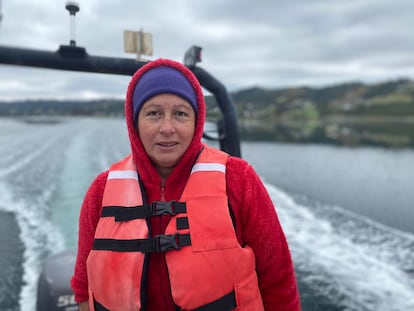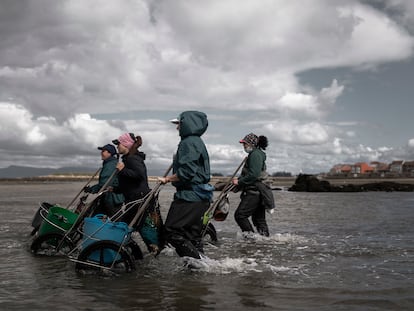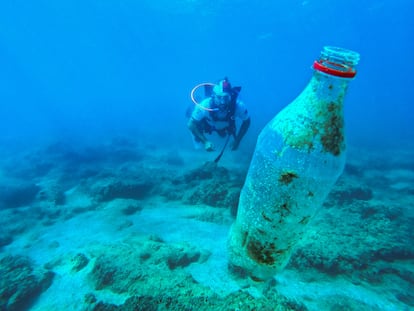Chile has 4,000 miles of coastline, but fish is scarce and expensive
To combat climate change and overexploitation, fishing communities are transforming their coves into sustainable and profitable fisheries
Julieta Nuñez, a 61-year-old shellfish diver, drops beneath the waves every day with a scuba tank on her back. She lives off the sea, diving for “locos,” a Chilean mollusk similar to an abalone. They are the main ingredient in “chupe de locos” (a seafood soup) and “locos con mayo” (an appetizer of locos topped with chopped onions, peppers and mayonnaise), two of the most expensive dishes in many Chilean seaside restaurants. There’s loco today in Concón (in the Valparaíso region), but fishing bans are sometimes imposed that can go on for months and even years. “I use a tank because I don’t like to rely on air from a tube attached to a compressor on the boat. I don’t get as much as some other people, but I prefer it that way,” she told us.
Nuñez found a few legal-sized locos earlier in the day among the rocks around San Pedro Cove and sold them to a local bar. She left the smaller ones in the sea to mature. Everybody follows this rule. As secretary of the fishers’ union in San Pedro de Concón, Nuñez met with the Valparaíso Governor Rodrigo Mundaca to ask for help regarding the ban on hake, decimated by overfishing. “The fishing is really bad — there’s less and less to catch. I don’t know what’s going on, but industrial fishing is leaving us with nothing to eat. Before, us regular folks could enjoy a good plate of fish, but now we can’t even do that anymore,” she said indignantly.
In Chile, there are 500 artisanal fishing units along 4,000 miles (6,000 kilometers) of coast. About 76% of these units are found in rural areas with high poverty. Approximately 97,000 artisanal fishers extract around 40% of the sea’s bounty, but these resources are slowly depleting.
“Over 50% of fisheries are currently overexploited, on the verge of collapse. It’s crucial to shift towards sustainable fishing practices to preserve biodiversity and ensure the sustainability of fishing for future generations. These principles are widely supported by artisanal fishermen in Chile and form the core objective of the Caletas Sustentables [Sustainable Coves] program,” said Claudia Razeto, who has led this non-profit program since 2019. The program is sponsored by Fundación Chile, a public-private partnership promoting sustainable development in Chile.
Razeto points out that climate change is adversely affecting ocean resources, forcing fishers to seek out new strategies. In a recent meeting in Costa Rica, the United Nations Food Agency (FAO) confirmed the multitude of challenges faced by coastal and riverine communities. “The rise in water temperature, powerful storm surges, and other phenomena have significant environmental, social, and economic consequences for those involved in fishing and aquaculture activities,” said the FAO.
Non-polluting buoys
Paola Cárcamo, president of the Aguas Azules Mussel Farmer Association in the Los Lagos region of southern Chile, grows a type of mussel called “choritos” for export. The country exports 80% of its mussels to Russia and China. “I am a Huilliche — it’s an ethnic group — which means people of the sea,” she said. Cárcamo wears rubber boots while cooking choritos with sausage and potatoes, an almost daily traditional meal for her and other Huilliches.
Cárcamo’s association also participates in the Caletas Sustentables program, which funded the replacement of buoy markers in their fishing areas. “Back in the day, they were all made with this super polluting polymer that would break down over time in the ocean,” she said. “It was legal — we all bought it legally. But it was a product that polluted way too much. It got released into the ocean and made it to the coasts where the birds, the poor little birds, ate it. Back when we applied for this project, this place was pretty much covered in these white, polluting buoys. Now we’ve replaced about 95% of them with non-polluting ones.”
Paola Cárcamo has seen a significant improvement in the area’s aquaculture after replacing the buoys. Not only did it result in a cleaner cove, but all the fishers managed to double their production. The previous buoys only allowed for linear mussel farming due to their smaller size. However, the new buoys, being larger, stronger and equipped with hooks, doubled their capacity. “We put a stop to pollution and doubled the mussel harvest. Who would’ve thought? And we even managed to ready our products for export by doing weekly toxicological analyses. We’re actually a team of 36 partners doing group exports,” said Cárcamo, who has gone out to sea every day since she was 9 years old. It’s a way of life and she loves it.
The old buoys were sent to recycling plants and made into flower pots and construction bricks — 80% of the material was reusable. Each year, the Caletas Sustentables program prevents 200 tons of waste from going into landfills. In Latin America, the FAO estimated that seafood loss and waste in 2016 reached 33%, from capture to consumption. “Loss and waste of these resources can vary based on the region and the stage in the supply chain. However, it’s clear that the highest losses happen during resource processing, distribution and capture,” said Razeto.

‘We waste nothing’
Marjorie Ojedais is the founder of Chiloé Mar y Tierra, a dehydrated seaweed product company in Ancud (Los Lagos region). She began small, selling “cochayuyo” (kelp) to local businesses, and later expanded to international clients in 2018. “We are seafarers. Our clients expect us to use the entire plant and minimize waste. We do this by cutting it into parts,” said Ojedais in a documentary about the project. “We waste nothing.” Her company recently received new stainless steel shelving from Caletas Sustentables to dry the edible kelp and produce a high-quality product.
Carlos Ojeda, a kelp harvester at Mar y Tierra, said: “It’s hard work, but Marjorie pays very well. When the sea is calm, we go diving to harvest cochayuyo, but we always make sure to leave a long stem so it can reproduce. Because if we pull out the roots, then we won’t have any cochayuyo left. It’s important to conserve for the future, for the generations to come.” In his hand, the man holds a strand of brown kelp — a once-cherished ingredient in traditional Chilean stews. Today, only a handful of youngsters will eat it.
According to Claudia Razeto, artisanal fishing is highly vulnerable to climate change. “Most people are fully aware that we need to make changes. And you know what? They actually do it, little by little. These changes are all about our culture. We’re all in when it comes to standing up against climate change. We believe in the strength of our fishers — we believe in them.”
But the men and women of the sea don’t hide their worries about the future. “Nobody wants to fish anymore, you know? I mean, who wants to go out at 4:00 in the morning with rough seas and not catch anything for five days in a row, right?” said Julieta Nuñez. “People used to say, ‘I’m going to be my own boss, just like my old man and grandpa. I’ll go to sea and fish.’ But, you know what? There aren’t any young folks out there fishing anymore. It’s only us old-timers, and we’re not too happy about it.”
Sign up for our weekly newsletter to get more English-language news coverage from EL PAÍS USA Edition
Tu suscripción se está usando en otro dispositivo
¿Quieres añadir otro usuario a tu suscripción?
Si continúas leyendo en este dispositivo, no se podrá leer en el otro.
FlechaTu suscripción se está usando en otro dispositivo y solo puedes acceder a EL PAÍS desde un dispositivo a la vez.
Si quieres compartir tu cuenta, cambia tu suscripción a la modalidad Premium, así podrás añadir otro usuario. Cada uno accederá con su propia cuenta de email, lo que os permitirá personalizar vuestra experiencia en EL PAÍS.
¿Tienes una suscripción de empresa? Accede aquí para contratar más cuentas.
En el caso de no saber quién está usando tu cuenta, te recomendamos cambiar tu contraseña aquí.
Si decides continuar compartiendo tu cuenta, este mensaje se mostrará en tu dispositivo y en el de la otra persona que está usando tu cuenta de forma indefinida, afectando a tu experiencia de lectura. Puedes consultar aquí los términos y condiciones de la suscripción digital.
More information
Archived In
Últimas noticias
Most viewed
- Reinhard Genzel, Nobel laureate in physics: ‘One-minute videos will never give you the truth’
- Oona Chaplin: ‘I told James Cameron that I was living in a treehouse and starting a permaculture project with a friend’
- Pablo Escobar’s hippos: A serious environmental problem, 40 years on
- Why we lost the habit of sleeping in two segments and how that changed our sense of time
- Chevy Chase, the beloved comedian who was a monster off camera: ‘Not everyone hated him, just the people who’ve worked with him’










































